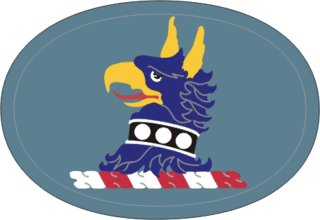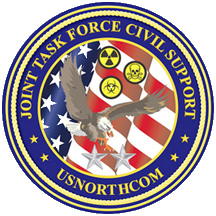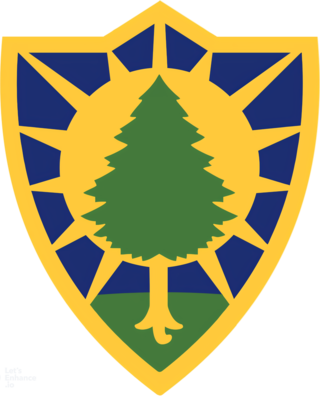
Chemical, biological, radiological and nuclear defense or NBC protection is protective measures taken in situations in which chemical, biological, radiological or nuclear hazards may be present. CBRN defense consists of CBRN passive protection, contamination avoidance, and weapons of mass destruction mitigation.

The United States Coast Guard Auxiliary is the uniformed civilian volunteer force, acting as an auxiliary force multiplier for the United States Coast Guard. Congress established the unit on 23 June 1939, as the United States Coast Guard Reserve. On February 19, 1941, the entity was renamed the United States Coast Guard Auxiliary. The Auxiliary's purpose is to bolster all USCG undertakings both at sea and in the sky, with the exception of tasks necessitating "direct" law enforcement or military actions. As of 2022, the U.S. Coast Guard Auxiliary boasted around 21,000 members.

The New York Guard (NYG) is the State Defense Force (SDF) of New York State, and is one of the four branches of the New York Military Forces (NYMF). Originally called the New York State Militia, it can trace its lineage back to the American Revolution and the War of 1812.
The Iraq War began with the US-led 2003 invasion of Iraq. The Government of Canada did not at any time formally declare war against Iraq, and the level and nature of this participation, which changed over time, was controversial. Canada's intelligence services repeatedly assessed that Iraq did not have an active WMD program.

Rapid Engineer Deployable Heavy Operational Repair Squadron Engineer squadrons are the United States Air Force's heavy-construction units. Their combat engineering capabilities are similar to those of the U.S. Navy Seabees and U.S. Army heavy-construction organizations.

The Delaware National Guard consists of the Delaware Army National Guard, and the Delaware Air National Guard. It is a state agency of the government of Delaware. From February 2017 its commander, the State adjutant general, has been Major General Carol A. Timmons.
The Maine Department of Defense, Veterans, and Emergency Management (DVEM) is a government agency in Maine. It comprises the two components of the Maine National Guard, the Maine Army National Guard and the Maine Air National Guard, the Bureau of Veterans' Affairs, the Maine Emergency Management Agency, and when it is active, the Maine State Guard. The Adjutant General of Maine, Brigadier General Doug A. Farnham, commands the Maine National Guard and serves as the State's Commissioner of Defense, Veterans, and Emergency Management (DVEM). The Maine Army and Air National Guard has responded to every call of the State and Nation since before the Revolutionary War. Their soldiers and airmen are trained to high standards and are ready to respond to combat missions, domestic emergencies, counterdrug efforts, reconstruction missions and more.

The Delaware Army National Guard is a component of the United States Army and the United States National Guard. National coordination of various state National Guard units are maintained through the National Guard Bureau.
The Mississippi Army National Guard is the Army National Guard component of the Mississippi National Guard. It was originally formed in 1798. It is a component of the United States Army and the United States National Guard. It is managed by the Mississippi Military Department.

The Defence Chemical, Biological, Radiological and Nuclear Centre is a United Kingdom military facility at Winterbourne Gunner in Wiltshire, south of Porton Down and about 4 miles (6 km) north-east of Salisbury. It is a tri-service location, with the Army being the lead service. The centre is responsible for all training issues relating to chemical, biological, radiological and nuclear (CBRN) defence and warfare for the UK's armed forces.

The 20th CBRNE Command is the United States Army headquarters for defense against Chemical, Biological, Radiological, and Nuclear weapons and high-yield explosives (CBRNE), headquartered on the site of the defunct Edgewood Arsenal chemical weapons production facility at Aberdeen Proving Ground in northern Maryland.

Joint Task Force Civil Support (JTF-CS) is a subordinate command of United States Northern Command headquartered at Fort Eustis. Its mission is to provide command and control for Department of Defense forces deployed in support of the National Response Plan, specifically, managing the consequences of a domestic chemical, biological, radiological, nuclear, or high-yield explosive (CBRNE) incident. JTFCS consists of discrete units of specialized consequence management troops from all services called the DOD CBRN Response Forces (DCRF), as well as civilian subject matter experts, assigned from various agencies. JTF-CS is able to respond anywhere in North America within 12 hours to lead technical and non-technical search and rescue, security, hazard analysis, evidence collection, mission command, logistics support, aviation support, and medical support after an actual or threatened CBRNE incident. JTF-CS is also a collaborative partner in planning for and responding to identified National Special Security Events (NSSE) around the United States.

The Oklahoma Military Department is an agency of the state of Oklahoma that serves as the administrative agency for all matters concerning the Oklahoma National Guard. Under the authority and direction of the Governor of Oklahoma as commander-in-chief, the agency is responsible for planning, establishing, and enforcing rules and procedures governing the administration, supply, and training of the Oklahoma National Guard, when not in the active service of the United States, the Oklahoma State Guard and the Oklahoma Unorganized Militia. The Department also maintains all state-owned, licensed or leased facilities, including Camp Gruber.
The Delaware Air National Guard (DE ANG) is the aerial militia of the State of Delaware, United States of America. It is, along with the Delaware Army National Guard, an element of the Delaware National Guard.
The United States Marine Corps is tasked by Department of Defense directive to "conduct complex expeditionary operations in the urban littorals and other challenging environments" and "conduct amphibious operations, including engagement, crisis response, and power projection operations to assure access." Before 2006, the Marine Corps was the only branch of the Armed Forces that did not have any of its special warfare elements participating in the United States Special Operations Command (USSOCOM), due to confining its special operations capabilities only for the purpose to the Fleet Marine Force.
Presidential Decision Directive 62 (PDD-62), titled Combating Terrorism, was a Presidential Decision Directive (PDD), signed on May 22, 1998 by President Bill Clinton. It identified the fight against terrorism a top national security priority.
A weapon of mass destruction Civil Support Team supports civil authorities in the event of the use, or threatened use, of a weapon of mass destruction. CSTs are federally funded units established under Presidential Decision Directive 39. There are 57 National Guard Teams and one Army Reserve full-time team: one in every U.S. state, Washington, D.C., Puerto Rico, Germany, Guam, and the US Virgin Islands with an additional team each in California, Florida, and New York.

The Deployable Operations Group (DOG) was a United States Coast Guard command that provided properly equipped, trained and organized Deployable Specialized Forces (DSF), which still exist today, to the Coast Guard, United States Department of Homeland Security (DHS), United States Department of Defense (DoD) and inter-agency operational and tactical commanders. Formerly headquartered in Arlington, Virginia, it was established on 20 July 2007, and was commanded by a captain and was decommissioned by the Commandant of the Coast Guard, Admiral Robert Papp on 1 October 2013, although many of the units existed long before the 2007 commissioning. Upon decommissioning, the units previously assigned to the DOG were split between Coast Guard Pacific and Atlantic Area commands.
The Domestic Emergency Support Team (DEST) is a rapidly deployable, interagency team of experts within the United States government, staffed from the Federal Bureau of Investigation (FBI), the Federal Emergency Management Agency (FEMA), the Department of Defense (DoD), the Department of Energy (DOE), the Department of Health and Human Services (HHS), and the Environmental Protection Agency (EPA). The DEST provides guidance to the FBI Special Agent in Charge (SAC) concerning weapons of mass destruction (WMD) threats and actual incidents/attacks.

The Maine Army National Guard is a component of the United States Army and the United States National Guard. Nationwide, the Army National Guard comprises approximately one half of the US Army's available combat forces and approximately one-third of its support organization. National coordination of various state National Guard units are maintained through the National Guard Bureau. The Guard is administered by the adjutant general, an appointee of the governor of Maine. The Constitution of the United States specifically charges the National Guard with dual federal and state missions. Those functions range from limited actions during non-emergency situations to full-scale law enforcement of martial law when local law enforcement officials can no longer maintain civil control.












